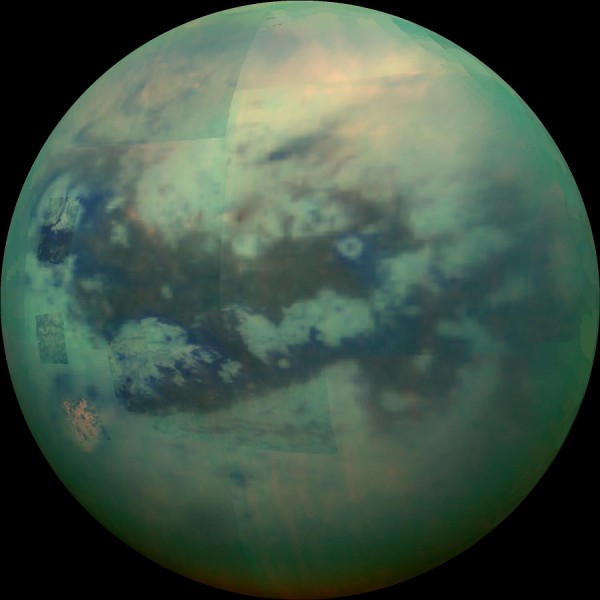By Ana Verayo, | April 03, 2017

This composite image shows an infrared view of Saturn's moon Titan from NASA's Cassini spacecraft. (NASA/JPL/University of Arizona/University of Idaho)
Scientists now suggest that the sand on Titan, which is Saturn's largest moon is apparently electrically charged. New findings reveal how these grains became charged over time as they come together in electrostatic, sticky clumps.
Apparently, this occurs when the granules resist motions and become attracted and attach themselves to other hydrocarbons.This phenomenon is called "saltation", when sandy grains become charged by powerful winds on the surface of Titan.
Like Us on Facebook
Now, scientists say that these electrically charged granules that cluster together can generate an electric charge that can last weeks or as long as a few months. According to Josef Dufek from the the Georgia Institute of Technology, if you were to build a sand castle on Titan and grabbed buckets of sandy grains, these will stick together for weeks due to electrostatic properties. So in the event of any spacecraft landing on the sand dunes or sandy regions of Titan, they will experience a hard time cleaning and getting rid of grainy sand particles.
Apart from these electrically charged particles that may cling on everything on Titan, this unique property is also the driving force behind the unique sand dune patterns of Titan. More specifically, Titan's massive sand dunes appear to be showing some movement in the opposite direction of the moon's major wind cycles that are blowing from east to west.
Scientists also revealed that since the sand grains possess such powerful electrical bonds, prevailing winds on Titan fail to disturb these current sand dune patterns. Titan's sand apparently contains naphthalene and biphenyl in which scientists were able to simulate them under laboratory conditions.
Researchers placed these two toxic compounds with sand grains and exposed them inside a modified pressurized tumbler, to mix the grains in a pure nitrogen rich environment within 20 minutes. Scientists then conducted measurements of the electrical properties of the sand particles.
The team revealed that after this experiment, most particles were stuck inside the tumbler. However, when sands and volcanic ash were exposed to simulated conditions found on Earth, none of the grains became stuck. This also means that geophysical properties of alien worlds can become challenging for landing spacecraft or rovers.
Dufek adds, since we are so accustomed to Earth's granular dynamics, landforms on other moons and planets are not naturally intuitive to us since they work on entirely different forces. Titan is a strange and sticky, electrostatic world.
This new study is published in the journal Nature Geoscience.
-
Use of Coronavirus Pandemic Drones Raises Privacy Concerns: Drones Spread Fear, Local Officials Say

-
Coronavirus Hampers The Delivery Of Lockheed Martin F-35 Stealth Fighters For 2020

-
Instagram Speeds Up Plans to Add Account Memorialization Feature Due to COVID-19 Deaths

-
NASA: Perseverance Plans to Bring 'Mars Rock' to Earth in 2031

-
600 Dead And 3,000 In The Hospital as Iranians Believed Drinking High-Concentrations of Alcohol Can Cure The Coronavirus

-
600 Dead And 3,000 In The Hospital as Iranians Believed Drinking High-Concentrations of Alcohol Can Cure The Coronavirus

-
COVID-19: Doctors, Nurses Use Virtual Reality to Learn New Skills in Treating Coronavirus Patients







